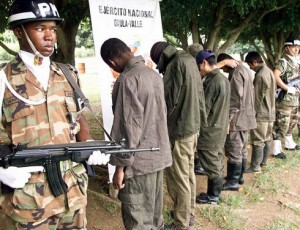Between 6,000 and 18,000 children remain in the hands of illegal armed groups.
The illegal recruitment of children is common in Colombia’s armed conflict.
The National Ombudsman’s Office estimates that about 6,000 children are in the hands of illegal armed groups, while the NGO Human Rights Watch puts the figure closer to 11,000.

“Recruitment is part of a methodical, systematic and deliberate policy directed at people in extremely vulnerable situations,” Natalia Springer, a Colombian expert on international law and human rights, wrote in her report “Like Lambs among Wolves.”
At least 18,000 minors have been recruited by illegal armed groups and criminal organizations, and at least 100,000 are linked to the illegal economy directly controlled by armed groups and criminal organizations, according to Springer’s report.
The majority of these minors are involved in invisible crime, as very few cases are reported and it’s impossible to know how many children die in combat.
In the first two months of 2014, 43 children escaped or were rescued from illegal armed groups after 332 deserted in all of 2013, according to the Ministry of Defense.
From Nov. 10, 1999 to March 31, 2013, 5,156 children and adolescents freed from illegal groups were attended to by the Colombian Institute for Family Welfare. Of these, 17% were rescued by the Public Forces and 83% turned themselves in voluntarily.
Child and adolescent labor forms an essential part of the strategy of illegal armed groups and criminal organizations. They train minors in numerous war-related skills, including combat, spying, delivering messages, providing tactical support and seeing to the primary needs of combatants by supplying food, first aid and even sexual favors, Col. Carlos Enrique Asprilla, the head of the Ministry of Defense’s Office for the Prevention of Recruitment and Use of Children by Illegal Armed Groups, said.
Regions, which include the departments of Antioquia, Putumayo, Nariño, Cauca, Guaviare and Norte de Santander, that have the highest rates of poverty, hunger and inaccessibility to drinking water, are the most vulnerable to child recruitment.
The principal cause of child recruitment is the proximity of armed conflict to areas with significant populations of children and adolescents, according to the report “Enough is enough! Colombia, memories of war and dignity.”
Children often are recruited by family members or acquaintances with links to illegal armed groups, Springer said.
Domestic abuse and violence, abandonment, orphanhood and the lack of opportunities for education and employment also play a role in minors’ seeking an “opportunity” to join an armed group, according to the report “Characterization of children and adolescents freed from illegal armed groups” by the United Nations Children’s Fund and Colombia’s Office of the Ombudsman.
“For illegal armed groups, children represent cheap labor for activities such as illegal mining and drug trafficking,” said Jorge Calero, the director of the Ombudsman’s Office’s Early Warning System. “They are more susceptible to training and possess physical attributes that are useful in combat situations.”
Springer said armed groups make recruited minors more aggressive by emotionally desensitizing them and teaching them military skills as part of the indoctrination process.
“The first weapon they gave us was part of a dead body so that we would get used to the smell of death and wouldn’t be afraid of the dead,” said a boy recruited by the United Self-Defense Forces of Colombia (AUC) in an interview with Springer.
In 2008, Colombia’s Constitutional Court made it illegal for armed groups to recruit minors, even if the minor wanted to join the group voluntarily.
Calero said the Revolutionary Armed Forces of Colombia (FARC) is more influential in rural areas, where the terrorist group extorts a “war tax” on families, while the emerging criminal groups (BACRIM) operate in urban areas, where they promise young people a better future.
More than 50% of BACRIM operatives haven’t reached the legal age of 18, while many children who were former members of the AUC, which disbanded in 2006, joined these groups due to failures in the disarmament and reintegration processes.
The Constitutional Court singles out the threat of recruitment as one of the principal causes of the forced displacement that has affected more than five million people nationwide, according to the government.
“It’s very difficult to rebuild the lives of people whose childhood has been stolen from them and whose bodies, minds and emotions have been molded by the logic of war,” said Vilma Gómez of the NGO Defense for Children International. “Those lucky enough to escape are treated as children, even though they have survived all kinds of horrible experiences that put an end to their childhood in an instant. Reinsertion is very confusing for them.”
Source: Infosurhoy.com

